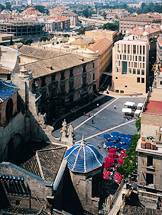José Rafael Moneo Arquitecto, the Madrid-based firm headed by
award-winning architect José Rafael Moneo, has been chosen to design
Princeton University's new neuroscience and psychology buildings.
Moneo, who is known for integrating contemporary architecture into rich
physical contexts, has taught architecture as well as practiced it. He
was chair of the Department of Architecture at Harvard University from
1985 to 1990 and currently lectures there as the first Josep Lluis Sert
Professor of Architecture.
He has taught at a number of other institutions including Princeton, where he served as a visiting professor in 1982.
"It is with great pleasure that I return to the Princeton University
campus for the design of the buildings for neuroscience and psychology
-- a project that aims to redefine science in the 21st century," Moneo
said. "I look forward to our close collaboration with the University
and the departments to design buildings that will merge the strict
requirements of research with the demanding complexities of the site."
The two buildings will be located south of the Icahn Laboratory and
will be part of a natural sciences neighborhood the University is
creating in the area south of Ivy Lane that straddles Washington Road.
One will house the Department of Psychology, which will move from Green Hall farther north on Washington Road. The other will house the new neuroscience institute,
announced in fall 2005, which will bridge many disciplines, including
psychology, and take an innovative approach to studying the brain and
nervous system. The buildings will be in close proximity and will be
connected by shared space.
"Moneo is very thoughtful and analytical in his approach as an
architect, and that's a nice fit for the buildings' uses," said
Princeton Executive Vice President Mark Burstein. "He's an architect
whose strength is in understanding the context of a site and designing
structures to be successful within that context."
Burstein noted that one of the challenges of the project will be to
design buildings for two academic units that want to maintain separate
identities yet foster cross-disciplinary work. The two structures will
be built on a site that borders a natural area. A sustainable design
strategy will be key, he said.
The buildings represent Moneo's first work at Princeton, which in the
last four years has selected several noted architects and their firms
for construction projects, including: Frank Gehry for the Lewis Library
to be completed in 2007; Demetri Porphyrios for Whitman College, also
to be completed in 2007; Frederick Fisher and Partners for a new
building for the Department of Operations Research and Financial
Engineering, a one-year project expected to begin in 2007; Pei Cobb
Freed & Partners for the reconstructed Butler College, set to begin
in 2007 and be finished in 2009; Hopkins Architects for the chemistry
building, slated to be started in 2007 and finished in 2010; and Renzo
Piano Building Workshop for an arts neighborhood design at the
intersection of University Place and Alexander Street, for which
preliminary plans will be unveiled this fall.

Award-winning design
Moneo, who established his firm in Madrid in 1965, is considered one of
the most important figures in Spanish architecture. In 1992, he
received the Spanish government's highest honor, the Gold Medal for
Achievement in Fine Arts. In 1996, he earned both the International
Union of Architects Gold Medal and the Pritzker Architecture Prize. The
citation for the former noted his great success in "creating a balance
between tradition and innovation."
In Spain, his projects include the Bankinter Building in Madrid, the
Museum of Roman Art in Mérida, the L'Illa building in Barcelona, the
Pilar and Joan Miró Museum in Palma de Mallorca, the town hall in
Murcia, the Kursaal Auditorium and Congress Center in San Sebastián and
the extension of the Prado Museum in Madrid.
In the United States, Moneo has designed the Davis Museum and Cultural
Center at Wellesley College, the Houston Museum of Fine Arts, the
Cathedral of Our Lady of the Angels in Los Angeles and the Laboratory
for Integrated Science and Engineering under construction at Harvard
University.
Moneo will work on the Princeton project with Davis Brody Bond, a New
York City firm with extensive science experience. The two currently are
collaborating on a science building at Columbia University.
The buildings should encompass about 200,000 gross square feet and
consist of multiple stories, according to Mark Wilson, program manager
in Princeton's Office of Design and Construction. They will incorporate
classrooms, laboratories, offices, meeting rooms and some specialty
spaces, such as a place to house the University's functional magnetic
resonance imaging (fMRI) scanner.
The buildings will be the focus over the next several years of
fund-raising efforts, which will determine the construction schedule.
The project site currently serves as a parking lot. Spaces for those
vehicles will be created elsewhere on campus as part of the
University's overall campus planning initiative.
The science neighborhood will include Fine, McDonnell, Jadwin and
Peyton halls and the new Lewis Library and chemistry building on the
east side of Washington Road and Thomas, Schultz, Moffett and Icahn
labs, Eno and Guyot halls and the new neuroscience and psychology
buildings on the west side. The two halves will be connected by a
pedestrian bridge being designed by noted Swiss engineer Christian Menn
in collaboration with HNTB, a New York-based architectural firm.

